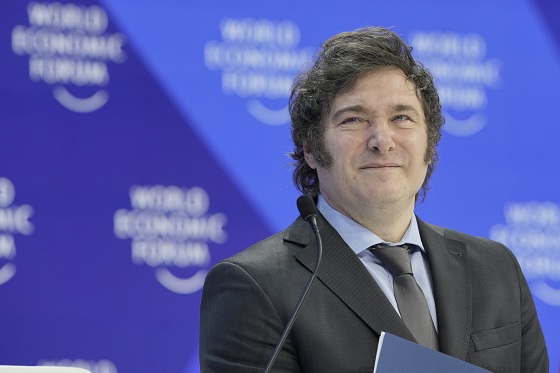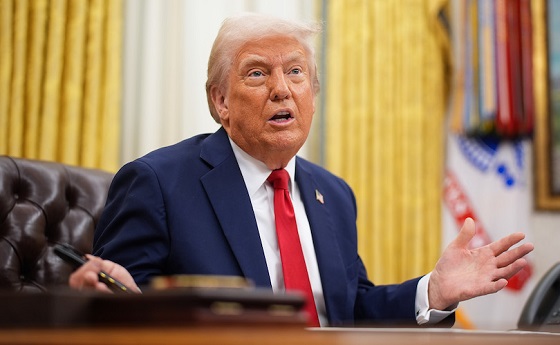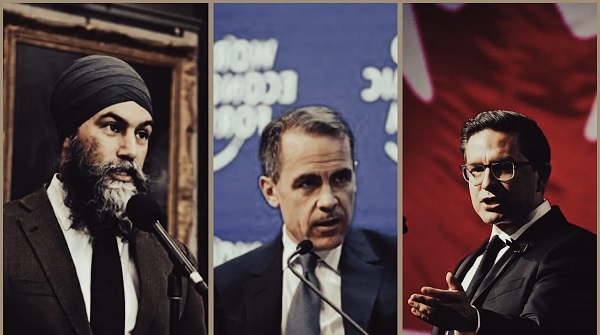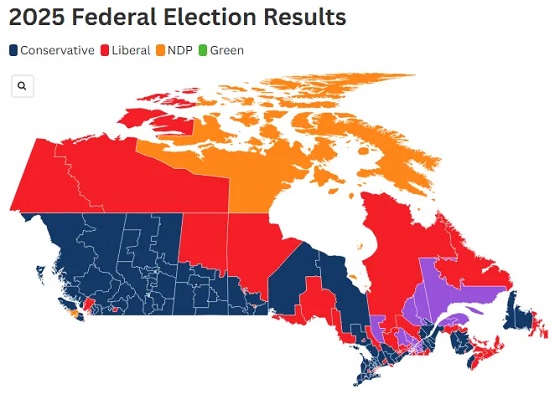International
Javier Millei declassifies 1850+ files on Nazi leaders in Argentina

 MxM News
MxM News
Quick Hit:
Argentine President Javier Milei has ordered the declassification of over 1,850 historical documents detailing the presence and activities of Nazi officials in Argentina following World War II. The move grants global public access to once-restricted files on high-profile Nazi figures, including Josef Mengele and Adolf Eichmann.
Key Details:
- The files are now publicly available online through an Argentine government portal.
- Notable entries document the postwar movements and false identities of infamous Nazi war criminals, such as Mengele and Eichmann.
- The declassified material was delivered to the Simon Wiesenthal Center to assist ongoing investigations into postwar Nazi financial networks.
Diving Deeper:
The decision by President Milei to declassify over 1,850 official records regarding Nazi officials in Argentina is a historic act of governmental transparency, and one that sheds further light on Argentina’s role as a haven for some of history’s most reviled war criminals.
Among the most chilling revelations are detailed police and immigration records concerning Josef Mengele, the SS doctor known as the “Angel of Death.” The files show Mengele arrived in Argentina in June 1949 using a falsified Italian identity under the name “Gregor Helmut,” facilitated by a passport issued by the International Red Cross. He successfully obtained Argentine legal status with help from the German embassy and remained in the country for years under official cover. Reports describe his profession as “manufacturer” and his later attempts to travel to both Chile and West Germany, supported by certificates of good conduct issued by local authorities.
Another document confirms that West Germany had requested Mengele’s extradition to face a life sentence, yet Argentina denied the request, citing procedural technicalities and taking no action—a decision that allowed Mengele to continue living in freedom in South America until his death in Brazil in 1979.
The files also include information on Adolf Eichmann, one of the chief architects of the Holocaust’s “Final Solution,” who lived in Argentina until his dramatic capture by Israeli Mossad agents in 1960. Additionally, declassified material references Martin Bormann, Hitler’s personal secretary, and Walter Kutschmann, a Gestapo officer responsible for mass atrocities in Poland who lived under an alias in Miramar.
The Argentine government stated that these files were compiled through investigations by the Foreign Affairs Directorate of the Federal Police, the State Intelligence Secretariat (SIDE), and the National Gendarmerie from the 1950s through the 1980s. Until this release, the information could only be viewed in a tightly controlled section of Argentina’s General Archive of the Nation.
The newly declassified files were also handed over to the Simon Wiesenthal Center, supporting its research into financial ties between Nazi officials and institutions like the Swiss-based Credit Suisse. The decision follows a February agreement between President Milei and representatives of the center.
Chief of Staff Guillermo Francos made it clear that this release was at the personal direction of Milei, noting in March, “President Milei gave the instruction to release all documentation [on Nazis who fled to Argentina after World War II] that exists in any State agency, because there is no reason to continue safeguarding that information.”
(AP Photo/Markus Schreiber)
Business
Trump’s bizarre 51st state comments and implied support for Carney were simply a ploy to blow up trilateral trade pact

From LifeSiteNews
Trump’s position on the Canadian election outcome had nothing to do with geopolitical friendships and everything to do with America First economics.
Note from LifeSiteNews co-founder Steve Jalsevac: This article, disturbing as it is, appears to explain Trump’s bizarre threats to Canada and irrational support for Carney. We present it as a possible explanation for why Trump’s interference in the Canadian election seems to have played a large role in the Liberals’ exploitation of the Trump threat and their ultimate, unexpected success.
To understand President Trump’s position on Canada, you have to go back to the 2016 election and President Trump’s position on the North American Free Trade Agreement (NAFTA) renegotiation. If you did not follow the subsequent USMCA process, this might be the ah-ha moment you need to understand Trump’s strategy.
During the 2016 election President Trump repeatedly said he wanted to renegotiate NAFTA. Both Canada and Mexico were reluctant to open the trade agreement to revision, but ultimately President Trump had the authority and support from an election victory to do exactly that.
In order to understand the issue, you must remember President Trump, Commerce Secretary Wilbur Ross, and U.S. Trade Representative Robert Lighthizer each agreed that NAFTA was fraught with problems and was best addressed by scrapping it and creating two separate bilateral trade agreements. One between the U.S. and Mexico, and one between the U.S. and Canada.
In the decades that preceded the 2017 push to redo the trade pact, Canada had restructured their economy to: (1) align with progressive climate change; and (2) take advantage of the NAFTA loophole. The Canadian government did not want to reengage in a new trade agreement.
Canada has deindustrialized much of their manufacturing base to support the “environmental” aspirations of their progressive politicians. Instead, Canada became an importer of component goods where companies then assembled those imports into finished products to enter the U.S. market without tariffs. Working with Chinese manufacturing companies, Canada exploited the NAFTA loophole.
Justin Trudeau was strongly against renegotiating NAFTA, and stated he and Chrystia Freeland would not support reopening the trade agreement. President Trump didn’t care about the position of Canada and was going forward. Trudeau said he would not support it. Trump focused on the first bilateral trade agreement with Mexico.
When the U.S. and Mexico had agreed to terms of the new trade deal and 80 percent of the agreement was finished, representatives from the U.S. Chamber of Commerce informed Trudeau that his position was weak and if the U.S. and Mexico inked their deal, Canada would be shut out.
The U.S. Chamber of Commerce was upset because they were kept out of all the details of the agreement between the U.S. and Mexico. In actuality, the U.S. CoC was effectively blocked from any participation.
When they went to talk to the Canadians the CoC was warning them about what was likely to happen. NAFTA would end, the U.S. and Mexico would have a bilateral free trade agreement (FTA), and then Trump was likely to turn to Trudeau and say NAFTA is dead, now we need to negotiate a separate deal for U.S.-Canada.
Trudeau was told a direct bilateral trade agreement between the U.S. and Canada was the worst possible scenario for the Canadian government. Canada would lose access to the NAFTA loophole and Canada’s entire economy was no longer in a position to negotiate against the size of the U.S. Trump would win every demand.
Following the warning, Trudeau went to visit Nancy Pelosi to find out if Congress was likely to ratify a new bilateral trade agreement between the U.S. and Mexico. Pelosi warned Trudeau there was enough political support for the NAFTA elimination from both parties. Yes, the bilateral trade agreement was likely to find support.
Realizing what was about to happen, Prime Minister Trudeau and Chrystia Freeland quickly changed approach and began to request discussions and meetings with USTR Robert Lighthizer. Keep in mind more than 80 to 90 percent of the agreement was already done by the U.S. and Mexico teams. Both President Andres Manuel Lopez Obrador and President Trump were now openly talking about when it would be finalized and signed.
Nancy Pelosi stepped in to help Canada get back into the agreement by leveraging her Democrats. Trump agreed to let Canada engage, and Lighthizer agreed to hold discussions with Chrystia Freeland on a tri-lateral trade agreement that ultimately became the USMCA.
The key points to remember are: (1) Trump, Ross, and Lighthizer would prefer two separate bilateral trade agreements because the U.S. import/export dynamic was entirely different between Mexico and Canada. And because of the loophole issue, (2) a five-year review was put into the finished USMCA trade agreement. The USMCA was signed on November 30, 2018, and came into effect on July 1, 2020.
TIMELINE: The USMCA is now up for review (2025) and renegotiation in 2026!
This timeline is the key to understanding where President Donald Trump stands today. The review and renegotiation is his goal.
President Trump said openly he was going to renegotiate the USMCA, leveraging border security (Mexico) and reciprocity (Canada) within it.
Following the 2024 presidential election, Prime Minister Justin Trudeau traveled to Mar-a-Lago and said if President Trump was to make the Canadian government face reciprocal tariffs, open the USMCA trade agreements to force reciprocity, and/or balance economic relations on non-tariff issues, then Canada would collapse upon itself economically and cease to exist.
In essence, Canada cannot survive as a free and independent north American nation, without receiving all the one-way benefits from the U.S. economy.
To wit, President Trump then said that if Canada cannot survive in a balanced rules environment, including putting together their own military and defenses (which it cannot), then Canada should become the 51st U.S. state. It was following this meeting that President Trump started emphasizing this point and shocking everyone in the process.
However, what everyone missed was the strategy Trump began outlining when contrast against the USMCA review and renegotiation window.
Again, Trump doesn’t like the tri-lateral trade agreement. President Trump would rather have two separate bilateral agreements; one for Mexico and one for Canada. Multilateral trade agreements are difficult to manage and police.
How was President Trump going to get Canada to (a) willingly exit the USMCA; and (b) enter a bilateral trade agreement?
The answer was through trade and tariff provocations, while simultaneously hitting Canada with the shock and awe aspect of the 51st state.
The Canadian government and the Canadian people fell for it hook, line, and sinker.
Trump’s position on the Canadian election outcome had nothing to do with geopolitical friendships and everything to do with America First economics. When asked about the election in Canada, President Trump said, “I don’t care. I think it’s easier to deal, actually, with a liberal and maybe they’re going to win, but I don’t really care.”
By voting emotionally, the Canadian electorate have fallen into President Trump’s USMCA exit trap. Prime Minister Mark Carney will make the exit much easier. Carney now becomes the target of increased punitive coercion until such a time as the USMCA review is begun, and Canada is forced to a position of renegotiation.
Trump never wanted Canada as a 51st state.
Trump always wanted a U.S.-Canada bilateral trade agreement.
Mark Carney said the era of U.S.-Canadian economic ties “are officially declared severed.”
Canada has willingly exited the USMCA trade agreement at the perfect time for President Trump.
Business
China’s economy takes a hit as factories experience sharp decline in orders following Trump tariffs

Quick Hit:
President Trump’s tariffs on Chinese imports are delivering a direct blow to China’s economy, with new data showing factory activity dropping sharply in April. The fallout signals growing pressure on Beijing as it struggles to prop up a slowing economy amid a bruising trade standoff.
Key Details:
- China’s manufacturing index plunged to 49.0 in April — the steepest monthly decline in over a year.
- Orders for Chinese exports hit their lowest point since the Covid-19 pandemic, according to official data.
- U.S. tariffs on Chinese goods have reached 145%, with China retaliating at 125%, intensifying the standoff.
Diving Deeper:
Three weeks into a high-stakes trade war, President Trump’s aggressive tariff strategy is showing early signs of success — at least when it comes to putting economic pressure on America’s chief global rival. A new report from China’s National Bureau of Statistics shows the country’s manufacturing sector suffered its sharpest monthly slowdown in over a year. The cause? A dramatic drop in new export orders from the United States, where tariffs on Chinese-made goods have soared to 145%.
The manufacturing purchasing managers’ index fell to 49.0 in April — a contraction level that underlines just how deeply U.S. tariffs are biting. It’s the first clear sign from China’s own official data that the trade measures imposed by President Trump are starting to weaken the export-reliant Chinese economy. A sub-index measuring new export orders reached its lowest point since the Covid-19 pandemic, and factory employment fell to levels not seen since early 2024.
Despite retaliatory tariffs of 125% on U.S. goods, Beijing appears to be scrambling to shore up its economy. China’s government has unveiled a series of internal stimulus measures to boost consumer spending and stabilize employment. These include pension increases, subsidies, and a new law promising more protection for private businesses — a clear sign that confidence among Chinese entrepreneurs is eroding under Xi Jinping’s increasing centralization of economic power.
President Trump, on the other hand, remains defiant. “China was ripping us off like nobody’s ever ripped us off,” he said Tuesday in an interview, dismissing concerns that his policies would harm American consumers. He predicted Beijing would “eat those tariffs,” a statement that appears more prescient as China’s economic woes grow more apparent.
Still, the impact is not one-sided. Major U.S. companies like UPS and General Motors have warned of job cuts and revised earnings projections, respectively. Consumer confidence has also dipped. Yet the broader strategy from the Trump administration appears to be focused on playing the long game — applying sustained pressure on China to level the playing field for American workers and businesses.
Economists are warning of potential global fallout if the trade dispute lingers. However, Beijing may have more to lose. Analysts at Capital Economics now predict China’s growth will fall well short of its 5% target for the year, citing the strain on exports and weak domestic consumption. Meanwhile, Nomura Securities estimates up to 15.8 million Chinese jobs could be at risk if U.S. exports continue to decline.
-

 Alberta2 days ago
Alberta2 days agoNew Alberta Election Act bans electronic vote counting machines, lowers threshold for recalls and petitions
-

 Alberta2 days ago
Alberta2 days agoHours after Liberal election win, Alberta Prosperity Project drumming up interest in referendum
-

 2025 Federal Election18 hours ago
2025 Federal Election18 hours agoNDP Floor Crossers May Give Carney A Majority
-

 Alberta2 days ago
Alberta2 days agoPremier Danielle Smith responds to election of Liberal government
-

 Alberta1 day ago
Alberta1 day agoPremier Danielle Smith hints Alberta may begin ‘path’ toward greater autonomy after Mark Carney’s win
-

 Banks2 days ago
Banks2 days agoTD Bank Account Closures Expose Chinese Hybrid Warfare Threat
-

 Business10 hours ago
Business10 hours agoChina’s economy takes a hit as factories experience sharp decline in orders following Trump tariffs
-

 2025 Federal Election2 days ago
2025 Federal Election2 days agoPost election…the chips fell where they fell

